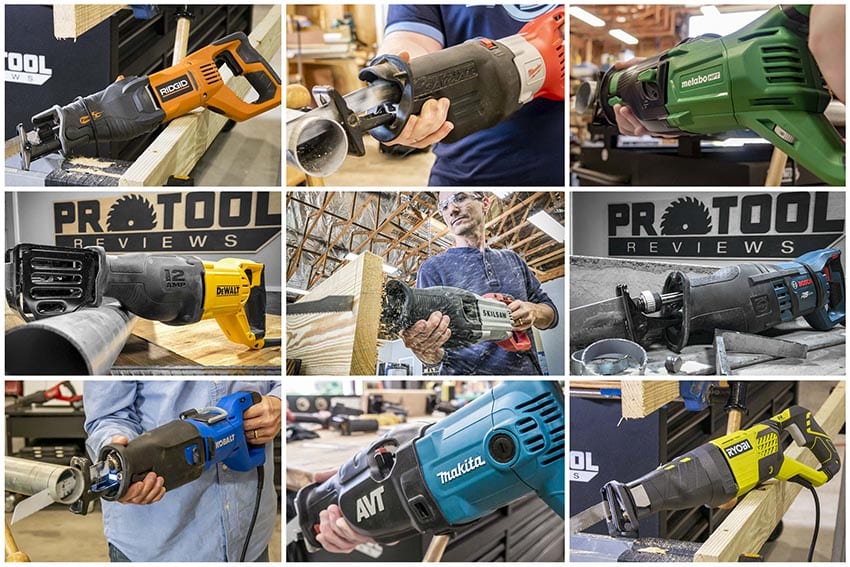Our search for the best corded reciprocating saw led us to two very distinct categories and one that sits between them. Often called by Milwaukee’s proprietary name, Sawzalls, these demolition tools represent a sector that still has a very strong corded presence.
What’s the Best Corded Reciprocating Saw Power Level?
There’s a big difference between using a 10-amp reciprocating saw and a 15-amp one. Both have their place and can be the best corded reciprocating saw—it just depends on what you’re cutting.
Reciprocating saws with 10 to 12-amp motors are high on value and trade-off performance for a lighter design. They’re a good choice for light-duty demolition and when you have to cut overhead.
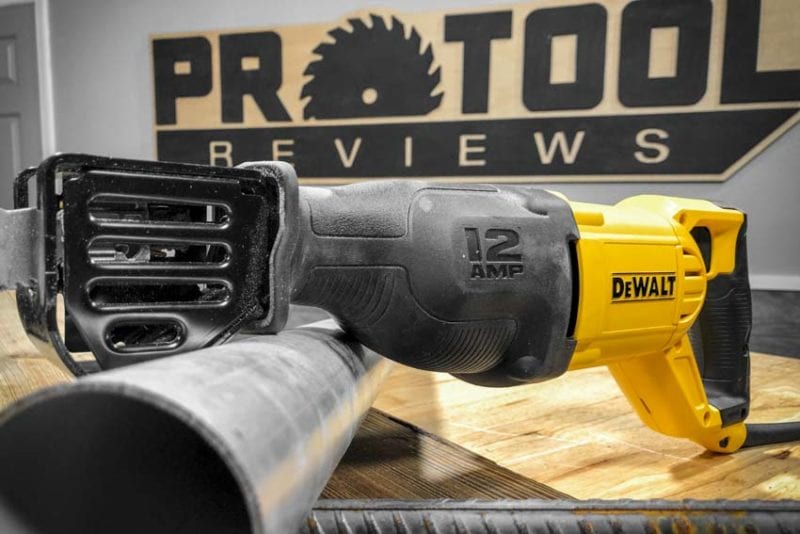
13-amp reciprocating saws sit in the gap between light-duty and heavy-duty cutting. They’re distinctly more powerful and heavier than their 10 to 12-amp counterparts and less powerful and lower weight than their 14 to 15-amp brethren. For some brands, this is the most powerful saw they make, and not every brand plays in this field. They’re a good compromise between the performance and size of the upper and lower classes.
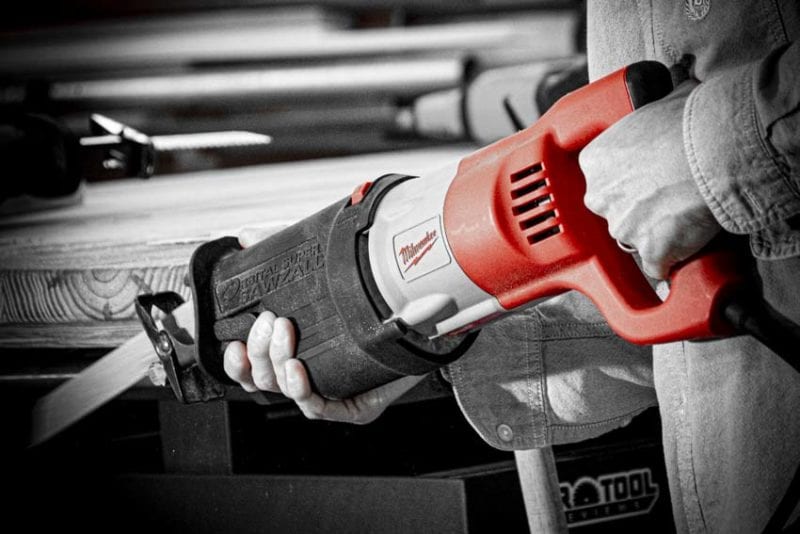
14 and 15-amp are where the heavyweights duke it out. It’s tempting to think these saws are raw muscle, but they’re quite a bit more than that. We see the best vibration control and feature sets here, often making them the best choice overall even though they’re heavier.
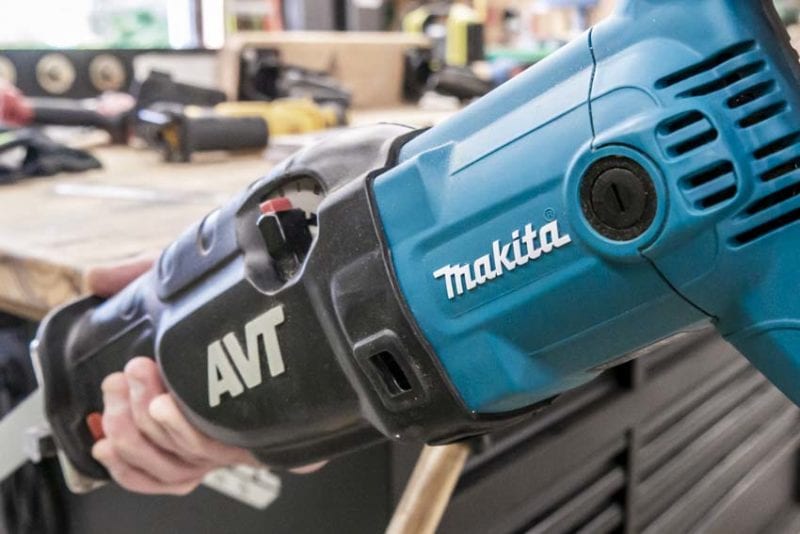
Best Corded Reciprocating Saw Overall
Skilsaw 15-Amp Reciprocating Saw with Buzzkill Technology SPT44-10
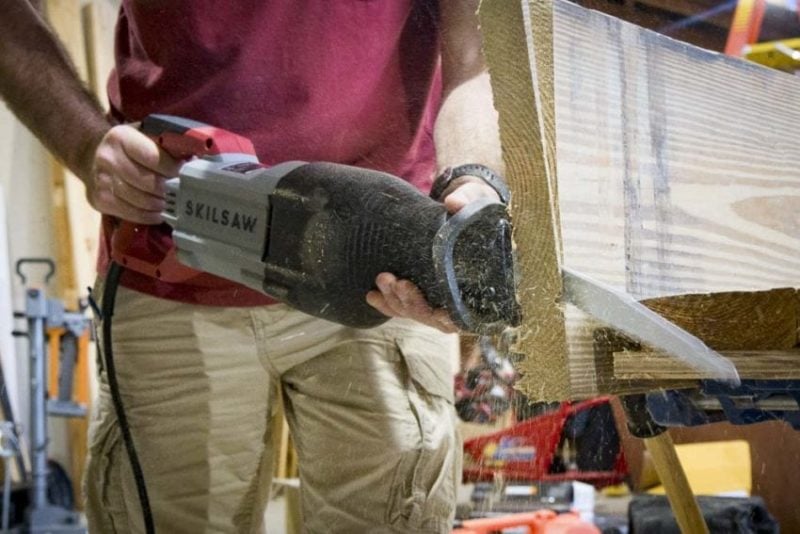
In a tight 3-way battle for the best corded reciprocating saw crown, Skilsaw’s 15-amp Buzzkill model edged out Makita and Milwaukee thanks to superior cutting speed and a higher value score. The trade-off for Skilsaw is that it’s a heavier tool. Regardless of which one you choose, all three of these tools are demolition beasts!
Best Corded Reciprocating Saw Cutting Speed
Skilsaw SPT44-10 15-Amp Reciprocating Saw with Buzzkill Technology
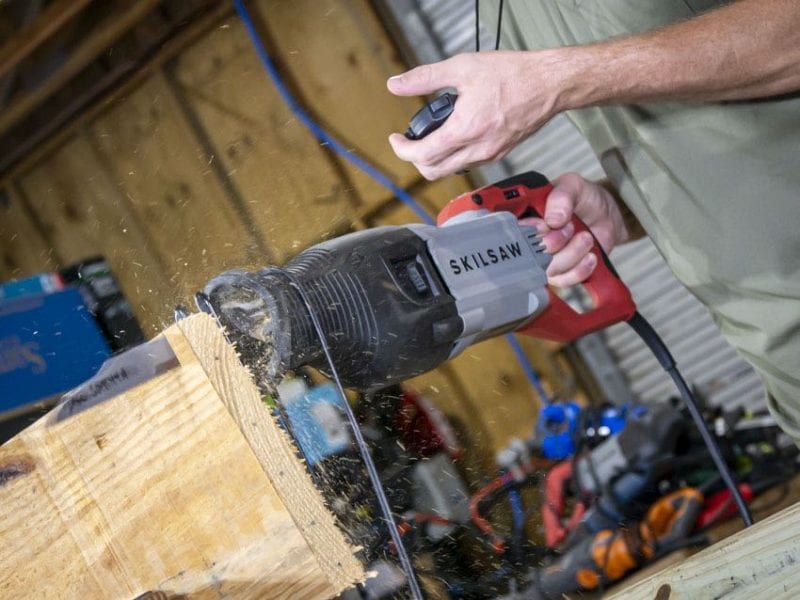
There’s no question the 15-amp class has the fastest cutting speeds and they’re the way to go for the best overall performance.
In our nail-embedded wood test, Skilsaw’s 15-amp Buzzkill took home the top time with Milwaukee’s 15-amp Super Sawzall close on its heels. Making things tougher with a roofing sandwich, the gap is almost identical, though both saws were slower.
It’s the same story when we switch to 2-inch EMT in our thin metal test. However, Skilsaw finally put a significant gap on Milwaukee in cutting rebar in our thick metal test.
In test after test, Skilsaw’s 15-amp Buzzkill model cut faster than anyone else in the 15-amp class. It’s the only saw we tested that led its class in every speed test.
The trade-off comes in weight. Not only are the 15-amp saws heavier than other power levels, but Skilsaw is also a hefty 2.6 pounds heavier than Milwaukee overall.
Best Corded Reciprocating Saw Vibration Control
Makita JR3070CTZ 15-Amp Recipro Saw
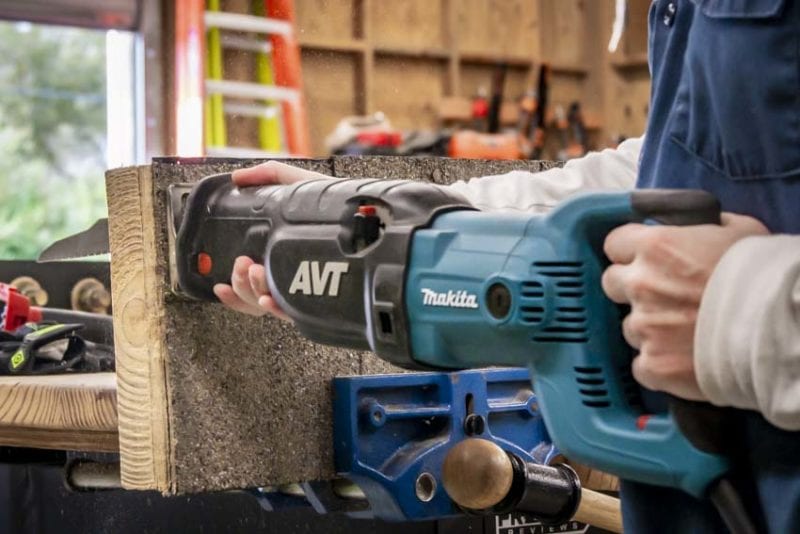
In general, lower power reciprocating saws have less vibration than the more powerful models. However, flagship 15-amp saws tend to have the benefit of the best vibration control development.
Makita’s AVT (Anti-Vibration Technology) design on their 15-amp JR3070CTZ swung our testers to award it the best vibration control in a close decision against Skilsaw’s Buzzkill technology.
In the lower power classes, Makita’s JR3050T is the best in the 10 – 12-amp group and Skilsaw’s Buzzkill has the advantage for the 13-amp saws.
Most Compact Corded Reciprocating Saw
Ridgid Fuego 10-Amp Orbital Reciprocating Saw
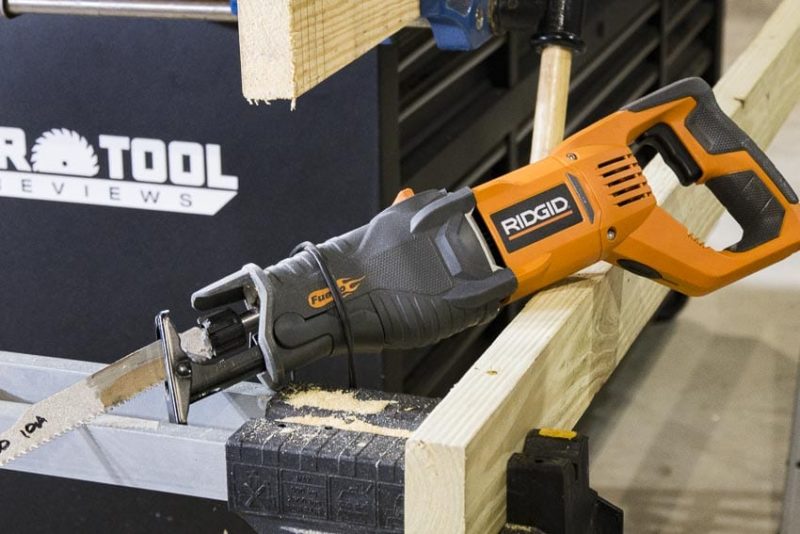
When you have to fit into small or awkward spaces, the 10 – 12-amp saws are your best best.
In this case, Ridgid sets itself up well as the lightest by 0.5 pounds and keeps its design tight, though DeWalt’s DWE305 is an inch shorter. Wrapping up both weight and size into a single call, Ridgid comes away with the best balance.
In the 13-amp class, the Milwaukee 6536-21 Super Sawzall gets the nod to go along with its excellent cutting performance as both the lightest and most compact in that group.
Milwaukee’s 6538-21 Super Sawzall and Bosch’s RS428 tie as the lightest in the 15-amp class with Bosch having the most compact frame.
Best Corded Reciprocating Saw Value
Skilsaw SPT44-10 15-Amp Reciprocating Saw with Buzzkill Technology
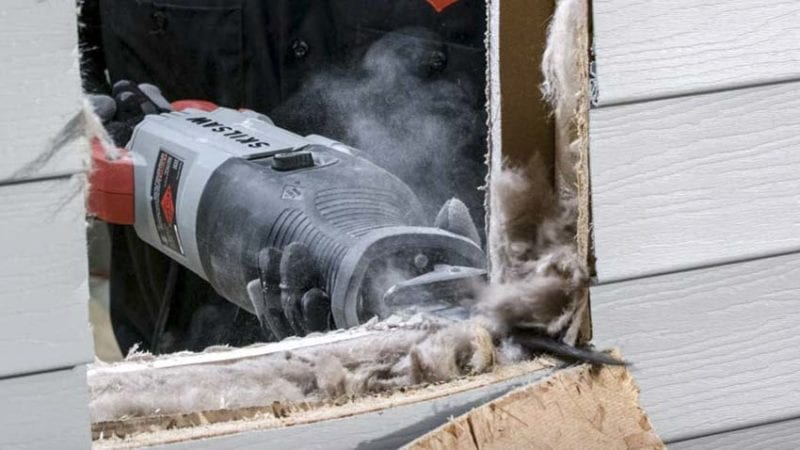
Value is more than just finding the cheapest corded reciprocating saw, it’s finding the best balance of design, performance, and price. For our money, Skilsaw’s 15-amp reciprocating saw performance and design attributes make up the cost difference when you’re looking for the best bang for your buck.
It’s not the only one to have a high value score, though. Here’s the full list that we believe gives you a lot for your money and score more than 90 points for value.
10 – 12-Amp
13-Amp
14 – 15-Amp
- Skilsaw SPT44-10: $169.00
Best Corded Reciprocating Saw: How We Tested
Cutting Speed
We designed 4 separate tests for each corded reciprocating saw to prove its worth. However, not every class is suited for the toughest tests, like our roofing sandwich—so we exempted all but the 15A models from that exercise.
Nail-Embedded Wood
This is our baseline test for every reciprocating saw we test. We timed how long it takes to cut through 2 x 10 PT pine with five 16D galvanized nail embedded in it and average each saw’s results. We strap a 5-pound weight to each saw to ensure they have an equal amount of downforce applied.
For this test, we use LENOX Demolition CT Carbide Tipped Blades. These 6 TPI blades last up to 6x longer than standard LENOX bi-metal blades in nail-embedded wood and their thick profile helps stabilize the cut. You can pick them in 6″, 9″, or 12″ lengths from your favorite LENOX retailer.
2″ EMT
To test metal cutting speed, we take the average time it takes to cut through 2″ EMT. Like the wood cutting test, we use a 5-pound weight for equal downforce.
In this test, we turn to LENOX LAZER 18 TPI medium metal bi-metal blades for 1/16″ – 1/4″ cutting. Their taller cutting profiles make more stable cuts and Power Blast design increases the overall life of the blade by increasing its strength. They’re available in 6″, 9″, or 12″ lengths.
#5 Rebar
For thick metal cutting speed, we test how long it takes to cut through #5 rebar (5/8″). Again, we’re using a 5-pound weight for downforce consistency.
In this brutal test, we switch the blades out to LENOX LAZER CT carbide blades for thick metal. Head-to-head against Milwaukee and Diablo, we made more cuts in rebar before teeth started coming off by a wide margin. Cut-for-cut, they’re the best thick metal blades we’ve ever tested. You can pick them up in 4″, 6″, and 9″ lengths.
Roofing Sandwich (15-Amp Class Only)
Only the toughest saws compete in our toughest test. With a sandwich of 2 x 10 PT, flashing, tar paper, asphalt shingles, and five 16D galvanized nails, we found the average time it takes for the 15-amp class to cut through.
We didn’t use a weight this time, though. You don’t have the luxury of using the weight of the saw to help you when you’re cutting apart a roof, so we cut freehand. To make sure we got consistent results, both Tom Gaige and I switched off making cuts.
We’re back to the LENOX Demolition CT Carbide Tipped Blades for this test.
Vibration
With all of our test materials available, we sent our team of three out at a time to cut to our heart’s content. Each of us had to rank each corded reciprocating saw on a 1–4 scale. Once we had all of the results without influencing each other, we tallied them up and averaged them out.
Feature Set
Generally speaking, corded tools don’t have as many bells and whistles as their cordless counterparts. There are still some important design features to consider, though. Here’s what we look for:
- Orbital Action
- Variable Speed Dial
- Pivoting, Tool-Free Adjustable Shoe
- Lever Blade Release (Not a Shaft Twist Lock)
- Rafter Hook/Belt Hook
- LED LightSpring Blade Ejection
- Unique Features
Size and Weight
When you’re using a tool that’s as aggressive as a reciprocating saw, the vibration and weight work against you as the day goes on. While each class moves up in weight with stronger motors, picking the best corded reciprocating saw for you might include some strong influence in the weight category.
Length isn’t as big of a consideration as it is in the cordless compact sector where you’re trying to get into really tight spots. However, if you’re a plumber, electrician, or working in another trade that forces you into some awkward spaces, it’s helpful to have a more compact saw.
Value
We take many things into consideration when we calculate value. It’s more than just the price—it’s what you get for what you pay. In other words, who gives you the most bang for your buck?
Why Corded Reciprocating Saws?
Despite an onslaught of cordless options, corded reciprocating saws continue to be a relevant sector. They’re far less expensive than their cordless counterparts, don’t have runtime issues (unless someone jacks your power supply), and they can take a beating.
For the time being, we see better vibration control development in corded tools as well. Makita’s AVT is very refined in its cordless saws and Skilsaw’s Buzzkill technology isn’t available on any cordless models.
Between the two power choices, cordless saws are catching and sometimes exceeding the cutting speeds of corded. Most standard 18V reciprocating saws are much faster than the 10 – 12-amp class for corded. Cordless models are even lighter weight in many cases.
Still, the benefits of lower cost and near-unlimited runtime continue to make the corded classes relevant on many jobsites.
Why You Can Trust Pro Tool Reviews
Ever check out a “review” site and you can’t tell if they actually tested the tools or if they’re just “recommending” the Amazon top sellers? That’s not us. We won’t recommend anything unless we’d actually use it ourselves and we don’t really care who the primary retailer is. It’s all about giving you a legitimate recommendation and our honest opinion of each product.
We’ve been in business since 2008 covering tools, writing reviews, and reporting on industry news in the construction, automotive, and lawn care industries. Our Pro reviewers work in the trades and have the skills and experience to know whether tools can perform well in the field.
Each year, we bring in and review more than 250 individual products. Our team will put our hands on hundreds of additional tools at media events and trade shows throughout the year.
We consult with innovators in the technology and design of tools to gain a broader grasp of where these products fit and how they work.
We work with more than two dozen professional contractors around the United States who review products for us on real job sites and consult with us on testing methods, categories, and weighting.
We’ll provide more than 500 pieces of new content this year absolutely free for our readers—including objective evaluations of individual tools and products.
The end result is information you can trust because of the editorial, scientific, and real-world professional experience we collectively utilize each and every time we pick up and test a tool.

